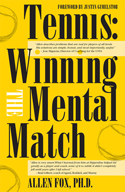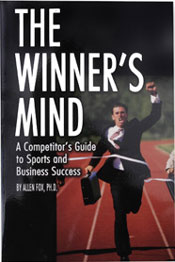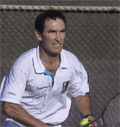Playing the Greats:
Stan Smith
By Allen Fox, Ph.D.
The lesson to be learned from the career of Stan Smith is that a simple game plan with little variation or adaptability can be extremely effective if it is executed well. Having many strategic options is not always a blessing. A plan where the player makes few decisions can improve execution by allowing him to concentrate fully on forcing his simple plan home.
Stan was at his prime in the early 1970's, when he won the US championship (1971) and Wimbledon (1972). As dedicated a work-horse as Roy Emerson, Stan was not as good an athlete as Emerson but was more a disciplined technician.
Where Emerson might spend hours simply running and smacking the ball, Stan would spend his time practicing his serve or working in exacting detail on the intricacies of some other stroke.
The first time I ever saw Stan he was about seventeen years old and all alone on a back court at the Los Angeles Tennis Club practicing his serve and volley. He was hitting serves and following each serve with a full-speed sprint all the way to the net.
For normal mortals it is boring enough to just practice serves all by oneself. It is worse running forward a few steps after each serve. But running all the way to net after every single serve is cruel and unusual punishment. Few players had the discipline to do it, but Stan was nothing if not disciplined.
Stan, of course, was working not only on his delivery, but also on the speed of his acceleration forward so he could get into the net quickly. In later years this paid him substantial dividends, because he was one of the best of all time at closing into the net so he could immediately put the ball away.
Stan was extremely aggressive. He came to net often and fast after both first and second serves, and at any other opportunity. He lacked finesse. His hands were strong but not supple.
In fact Stan was the un-McEnroe, often miss-hitting volleys, but having managed to get in very close to the net, Stan was able to put the ball away anyway. He roared into the net at high speed and woe unto the opponent who hit slow, hanging balls. Stan was on top of the net in an instant to bury these.
Stan was able to play close to the net because of his size, ability to jump, and his great overhead. Stan was 6' 4" tall and an excellent basketball player. For his size he was quite quick and a terrific jumper. If you lobbed and Stan managed to reach the ball (which he was very likely to do) you were virtually sure to lose the point.
I played Stan many times and his fearsome overhead was a particular problem to me. When I was attacked at the net and found myself too far off court or off balance to hit a reasonable passing shot, my normal response was to throw up a sky-high lob and force my opponent to hit an overhead deep in the court off the bounce. From there I was quite good at scrambling back the overhead and continuing the point.
Against Smith this was hopeless. His overhead was so good that you might as well catch the ball as give him a bouncing overhead, no matter how deep or high the lob was. And you were not much better off lobbing his backhand overhead.
This is a soft spot with most volleyers. The backhand overhead requires tremendous strength and few players have enough to really do you damage. If you can pitch the lob up over their backhand sides and make them hit this shot while jumping or off-balance, you can generally keep the point going and get an opportunity at a reasonable passing shot.
Smith, on the other hand, was capable of bouncing backhand overheads over the fence, so lobbing this side was virtually hopeless as well. Nastase experienced some of the same problems that I did and in exasperation nicknamed Smith "Godzilla" in deference to his size and almost incredible strength.
Smith hit both forehand and backhand groundstrokes hard and with light topspin. They were not pretty, often being hit off-center, and lacking finesse or clever placement. But they were effective. Stan hit them as hard as he could and simplistically aimed for anywhere in the court that you didn't happen to be. If you managed to run the ball down Stan simply whacked it again into the opposite side.
This strategy was particularly disconcerting to me, since I was a touch player and liked to maneuver with my opponent. I was very good at guessing where my opponents were going to hit the ball, and I loved it when they tried to trick me and hit behind me. I almost always got the best of players that attempted to be clever. Unfortunately for me, Stan rarely tried to be clever. He hit for the opening and it was only a question of whether you could run fast enough to reach the ball.
 |
Stan’s size, reach and speed made him very difficult to pass. |
It was also very unrewarding to try clever, touch passing shots against Stan. He was so big and fast that if he were given any time at all he would reach out a long arm and get to almost anything. The best play against Stan was to whack the ball hard into an opening before he had time to react and move or reach.
Unfortunately for me, I specialized in tricky delicate passing shots and lobs, designed to keep an opposing net-rusher off balanced and confused. Stan was my worst nightmare. He didn't get confused and his balance was awfully good.
My tournament record against Stan was 1 win against 5 losses, with my lone win coming the first time I played him when he was 18 years old and national junior champion. I was in my mid-twenties and very experienced.
Being short and tricky, I specialized in chopping up inexperienced junior players They didn't know what I was going to do with the ball and I knew exactly what they were going to do. It was a formula designed to provide me with hours of fun and them with hours of frustration and misery (which, come to think of it, was what constituted so much of my fun).
I slaughtered Stan in the Southern California championship about 6-1, 6-1 and didn't give him another thought for a year. It was then that I ran into him in the finals of the Tucson Invitational where he beat me in three close sets after beating Charlie Pasarell in the semis. He wasn't great, but he was enormously improved from the previous year.
 |
Stan had a self-assured confident to go along with a big serve. |
In the ensuing years we played four more times and he beat me worse every time. By the end he was just teeing off on everything I hit and blasting me off the court.
Because of this I became very irritable playing Stan. I felt weak, frustrated, and most of all, short. Stan towered over me by eight inches, and I felt like a pigmy. The heavier he served and the harder he hit, the more I felt like I was shrinking
And Stan didn't help matters by his attitude. He was supremely confident-- a nice guy totally honest, hard-working, decent, forthright, and admirable in every way --yet I found him very annoying to play. He walked in a very erect and self-assured manner, almost supercilious. In fact, he appeared cocky even though he really wasn't.
Stan hardly acknowledged your presence across the net and never seemed even slightly perturbed if you hit the greatest shot in the world. His walk never changed and his facial expression was serene. It was bothersome that he seemed not to notice that you were alive. His attitude hinted of "That was a nice little shot, but it won't do you any good since there is no question that I will win the match anyway."
Stan's composure was sorely tested during the final round of the Davis Cup in 1972 when he defeated both Ilie Nastase and Ion Tiriac in Bucharest Romania , leading the US team to a 3-2 victory in the face of some of the worst sportsmanship and line calls yet seen in that event.
 |
Stan’s determination and hard work carried him to victories over Ilie Nastase at Wimbledon and in the Davis Cup |
At that time it was still a gentleman's game and the players genuinely cared about their reputations for honesty and sportsmanship. No one was yet accustomed to being cheated by an opponent or putting up with disrespectful, "in your face" types of gestures. Nastase was well on the way to changing all of that and the money in the newly open game provided leverage enough to keep the officials docile.
Although Stan's tenure at the top of the game was brief, he was a wonderful champion and represented the highest virtues of the game's great players --serenity in the face of adversity, discipline, hard work, and single-mindedness of purpose.






